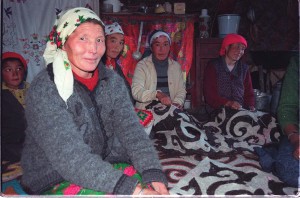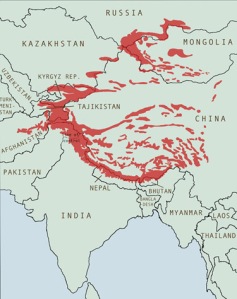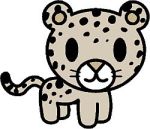
Kazak women making beautiful rugs in Mongolia. Photo Charles Dye. Courtesy SLT.
Mongolia hosts about 13–22% of the estimated global snow leopard population in less than 10% of the total range of the species.
Snow leopards are widely distributed in the mountains of Western Mongolia and inhabit the Altai Mountains, Khangai Mountains, Khan-Khokhii Mountains and Kharkhiraa, Turgen, Tsagaan Shuvuut Mountains, and in isolated mountainous sections of the Trans-Altai Gobi.
According to WWF, population estimates of snow leopard in Mongolia vary from about 700 to 1200 but as in most places the numbers are in decline due to poaching for fur and bones to be sold on the black market, retaliation killings and loss of prey species as human overhunt ibex, argali, marmots and other animals the snow leopard depends on.
Snow Leopard Trust Programs
In early 2008 the Trust started a 10 year program in co-operation with the Mongolian government and several other conservation groups. To date they have captured and radio collared 5 snow leopards and are following their movements and collecting data on range and predation. The Trust runs an exciting ongoing blog with stories about the cats, the harsh environment, the local wildlife and the local communities.

Longtail, who was killed by a herder in Mongolia. Photo SLT.
Recently the tragedy of retaliation killing was brought home to the team when one of the collared cats they had been studying for months, “Longtail”, was killed by a local herder who had lost many sheep to snow leopards. The Trust conducted an investigation (see report) which once again showed the need for better protection of livestock and more programs to compensate herders for livestock loss.
Talking about the future of this program, Tom McCarthy, the trust’s conservation director – “Although there have been several valuable studies of the species to date, most were short-term, or at most four or five years in duration, and such short-term efforts simply cannot provide the understanding we need to conserve these cats”.
Mongolia was chosen for the new study because it has some 1,000 snow leopards in the wild, the second largest population after China, and hosts existing conservation programs involving more than 400 herder families in the remote Altai mountains in the far west of the country.

Sainbileg from Snow Leopard enterprises in Mongolia. Photo courtesy of SLT.
The Trust also runs a Community Conservation Program, supporting villagers in the making of beautiful hand made rugs using the wool from their own livestock. These stunning rugs and other items are sold through the Trust and all the money goes back to the women and their communities, providing money for food, medicine and education. Where people have an alternative source of income it is less likely they need to kill snow leopards either to sell illegally or in retaliation for livestock killings.
WWF
WWF have had many snow leopard programs in Mongolia since the 1990’s. These include research programs trying to establish snow leopard numbers, programs setting up antipoaching units and snow leopard educational programs for rural people.
WWF Mongolia recently developed a program where teachers are introduced to education for sustainable development. A national network of teams has been created in all the provinces in Mongolia and these teams provide expertise and experience in how to increase environmental awareness to school teachers in their areas so they in turn can teach children to be more environmentally aware.
Snow Leopard Conservancy

Togoldor, a wild male snow leopard being radio collared in Mongolia. Photo by SLC.
In September, 2008, a team including Rodney Jackson, Dr. B Munkhtsog, Duggin Wroe, ace mountain lion and jaguar tracker and trapper, and a volunteer veterinarian experienced in wildlife immobilisation captured an adult male snow leopard in Mongolia and fitted him with a satellite collar. The team named the cat “Togoldor”, which means very great, amazing, incredible. The snow leopard’s GPS collar has been sending locations, which the SLC is tracking via computer.
Check out the video of Togoldor’s movements for the last 3 months over his home mountain range. You can see the distances he travels and the way he seems to come back to the same area time and time again.









